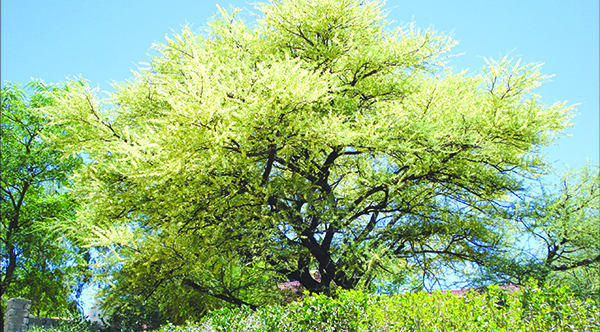• LUISE HOFFMANNTHIS medium to tall single-stemmed tree is currently easy to identify because it is thickly covered in millions of tiny creamy-white and sweetly scented ball-shaped flowers. If the rains stay away for lengthy periods, these trees may flower more than once during a rainy season.
The umbrella thorn has the smallest flowers of all the acacias occurring in Namibia. They fill the air with an exquisitely delicate scent attracting many insects.
Names: G. Ringelhülsenakazie, Schirmakazie; A. haak-en-steek, krulpeul; H. orusu orupunguiya; N/D /narab
While being reported from a few scattered localities south of 25°S, the umbrella thorn is very common northwards of this demarcation and only absent from some of the very sandy areas in south-eastern Namibia. The umbrella thorn usually grows away from rivers and drainage lines.
It may reach a height of 15 m. Young trees tend to be shrubby and thickly covered in straight white spines, the hooked thorns only developing as the tree matures. Middle aged trees have large rounded crowns while old trees develop the spreading, flat crown so characteristic of the African savannah landscape. The dark brown to dark grey bark is deeply fissured and comes off in long strips. The feathery leaves are twice divided and only about 3cm long.
Paired short hooked thorns and paired straight white spines grow on the same tree intermingled with pairs consisting of one straight and one hooked thorn. The hooked thorn in this case is often more easy to feel than to see. The botanical name “heteracantha” means ‘alternating thorns’. The Afrikaans common name refers to thorns that grab: “haak” and spines that prick: “steek”’.
The pods – narrow, yellow-grey to light brown in colour, twisted in corkscrew spirals – are the most distinctive feature of this tree. The botanical name “tortilis”, as well as German “Ringelhülse” and Afrikaans “krulpeul”, all meaning ‘contorted pods’, refer to these pods.
The pods contain much protein and are eagerly foraged by most antelope as well as giraffe and of course cattle and goats. The pods are often collected as cattle fodder. Damara dikdiks and black-faced impala browse the leaves. Elephants tend to tear off long strips of the bark, thereby often destroying the trees. Secretary birds like to roost on the flat crown.
The dark heartwood is dense and heavy. Nevertheless it is frequently attacked by insects. It makes good fire-wood and the thorny branches are used for livestock enclosures. The tree secretes an edible gum.
Umbrella thorn trees are beautiful, characteristically African trees suitable for large gardens and parks and for planting along roads and streets. Seeds placed in boiling water and soaked for 24 hours germinate easily, but the trees do not grow very fast. They develop a long tap root and are reasonably frost and drought resistant. Young trees are shrub like and thickly covered in long white thorns.
Acacia tortilis subsp. spirocarpa occurs from the Waterberg northwards, is less common than the above subspecies and usually grows on alluvial substrates. It has broader, less tightly curled pods covered with dense woolly hairs and a wider and flatter crown than A. tortilis subsp. heteracantha.
Stay informed with The Namibian – your source for credible journalism. Get in-depth reporting and opinions for
only N$85 a month. Invest in journalism, invest in democracy –
Subscribe Now!






